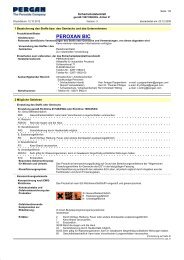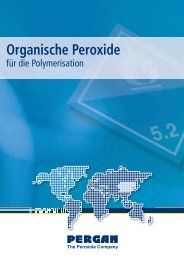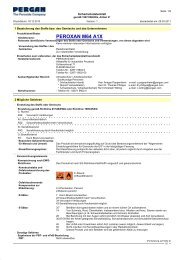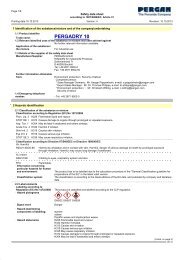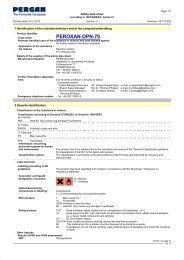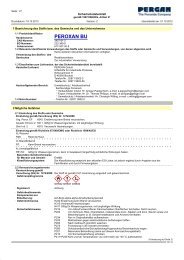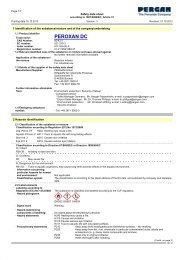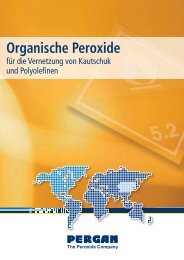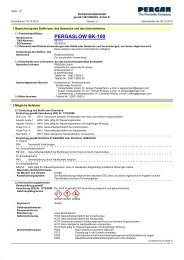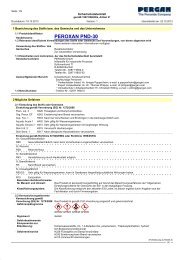PEROXAN BHP-70 - Pergan GmbH
PEROXAN BHP-70 - Pergan GmbH
PEROXAN BHP-70 - Pergan GmbH
Create successful ePaper yourself
Turn your PDF publications into a flip-book with our unique Google optimized e-Paper software.
35.0.33<br />
Page 1/9<br />
Printing date 19.10.2012<br />
Safety data sheet<br />
according to 1907/2006/EC, Article 31<br />
Version: 3<br />
Revision: 19.10.2012<br />
1 Identification of the substance/mixture and of the company/undertaking<br />
· 1.1 Product identifier<br />
· Trade name: <strong>PEROXAN</strong> <strong>BHP</strong>-<strong>70</strong><br />
· 1.2 Relevant identified uses of the substance or mixture and uses advised against<br />
No further relevant information available.<br />
· Application of the substance /<br />
the preparation Reaction initiator<br />
For industrial use<br />
· 1.3 Details of the supplier of the safety data sheet<br />
· Manufacturer/Supplier: PERGAN <strong>GmbH</strong><br />
Hilfsstoffe für industrielle Prozesse<br />
Schlavenhorst 71<br />
D-46395 Bocholt<br />
Tel: +49 2871 9902-0<br />
Fax: +49 2871 9902-50<br />
· Further information obtainable<br />
from: Environment protection / Security of labour<br />
Competent person:<br />
* Sales Manager Germany: Mr. Ansgar Pappenheim, e-mail: a.pappenheim@pergan.com<br />
* Export Sales Manager: Mr. Dr. Thomas Philipps, e-mail: dr.philipps@pergan.com<br />
* Environment protection / : Mr. Christoph Wilting, e-mail: c.wilting@pergan.com<br />
Security of labour<br />
· 1.4 Emergency telephone<br />
number: - Tel: +49 2871 9902-0<br />
* 2 Hazards identification<br />
· 2.1 Classification of the substance or mixture<br />
· Classification according to Regulation (EC) No 1272/2008<br />
Flam. Liq. 3 H226 Flammable liquid and vapour.<br />
Org. Perox. EF H242 Heating may cause a fire.<br />
Acute Tox. 3 H311 Toxic in contact with skin.<br />
Acute Tox. 2 H330 Fatal if inhaled.<br />
Muta. 2 H341 Suspected of causing genetic defects.<br />
Skin Corr. 1B H314 Causes severe skin burns and eye damage.<br />
Aquatic Chronic 2 H411 Toxic to aquatic life with long lasting effects.<br />
Acute Tox. 4 H302 Harmful if swallowed.<br />
Skin Sens. 1 H317 May cause an allergic skin reaction.<br />
· Classification according to Directive 67/548/EEC or Directive 1999/45/EC<br />
T; Toxic<br />
R23: Toxic by inhalation.<br />
C; Corrosive<br />
R34: Causes burns.<br />
Xn; Harmful<br />
R21/22-68: Harmful in contact with skin and if swallowed. Possible risk of irreversible effects.<br />
Xi; Sensitising<br />
R43: May cause sensitisation by skin contact.<br />
O; Oxidising<br />
R7: May cause fire.<br />
N; Dangerous for the environment<br />
R51/53: Toxic to aquatic organisms, may cause long-term adverse effects in the aquatic environment.<br />
R10: Flammable.<br />
· Information concerning<br />
particular hazards for human<br />
and environment: The product has to be labelled due to the calculation procedure of the "General Classification guideline for<br />
preparations of the EU" in the latest valid version.<br />
· Classification system: The classification is according to the latest editions of the EU-lists, and extended by company and literature<br />
data.<br />
· 2.2 Label elements<br />
· Labelling according to<br />
Regulation (EC) No 1272/2008 The product is classified and labelled according to the CLP regulation.<br />
· Hazard pictograms<br />
~� ~� ~� ~� ~�<br />
GHS02 GHS05 GHS06 GHS08 GHS09<br />
(Contd. on page 2)<br />
GB
35.0.33<br />
Page 2/9<br />
Printing date 19.10.2012<br />
Safety data sheet<br />
according to 1907/2006/EC, Article 31<br />
Version: 3<br />
Revision: 19.10.2012<br />
Trade name: <strong>PEROXAN</strong> <strong>BHP</strong>-<strong>70</strong><br />
(Contd. of page 1)<br />
· Signal word<br />
· Hazard-determining<br />
Danger<br />
components of labelling: tert-butyl hydroperoxide<br />
· Hazard statements H226 Flammable liquid and vapour.<br />
H242 Heating may cause a fire.<br />
H302 Harmful if swallowed.<br />
H311 Toxic in contact with skin.<br />
H330 Fatal if inhaled.<br />
H314 Causes severe skin burns and eye damage.<br />
H317 May cause an allergic skin reaction.<br />
H341 Suspected of causing genetic defects.<br />
H411 Toxic to aquatic life with long lasting effects.<br />
· Precautionary statements P210 Keep away from heat/sparks/open flames/hot surfaces. - No smoking.<br />
P220 Keep away from dirt, rust, chemicals in particular concentrated acids, alkalis and<br />
accelerators (e. g. heavy metal compounds and amines).<br />
P234 Keep only in original container.<br />
P243 Take precautionary measures against static discharge.<br />
P264 Wash thoroughly after handling.<br />
P273 Avoid release to the environment.<br />
P280 Wear protective gloves/protective clothing/eye protection/face protection.<br />
P284 Wear respiratory protection.<br />
P303+P361+P353 IF ON SKIN (or hair): Remove/Take off immediately all contaminated clothing. Rinse skin<br />
with water/shower.<br />
P305+P351+P338 IF IN EYES: Rinse cautiously with water for several minutes. Remove contact lenses, if<br />
present and easy to do. Continue rinsing.<br />
P310 Immediately call a POISON CENTER or doctor/physician.<br />
P320 Specific treatment is urgent (see on this label).<br />
P405 Store locked up.<br />
P410 Protect from sunlight.<br />
P411+P235 Store at temperatures not exceeding +30°C. Keep cool.<br />
P420 Do not mix with peroxide-accelerators or reducing agents.<br />
P501 Dispose of contents/container in accordance with local/regional/national/international<br />
regulations.<br />
· 2.3 Other hazards<br />
· Results of PBT and vPvB assessment<br />
· PBT: Not applicable.<br />
· vPvB: Not applicable.<br />
3 Composition/information on ingredients<br />
· 3.2 Chemical characterization: Mixtures<br />
· Dangerous components:<br />
CAS: 75-91-2<br />
EINECS: 200-915-7<br />
Reg-No.:01-21194466<strong>70</strong>-40<br />
tert-butyl hydroperoxide<br />
T R23; C R34; Xn R21/22-68; Xi R43; O R7; N R51/53<br />
R10<br />
Org. Perox. A, H240; Acute Tox. 3, H311; Acute Tox. 2, H330; Muta. 2, H341; Skin Corr. 1B, H314; Eye<br />
Dam. 1, H318; Aquatic Chronic 2, H411; Acute Tox. 4, H302; Skin Sens. 1, H317; Flam. Liq. 2, H225<br />
· Additional information: For the wording of the listed risk phrases refer to section 16.<br />
4 First aid measures<br />
· 4.1 Description of first aid measures<br />
· General information: Immediately remove any clothing soiled by the product.<br />
Symptoms of poisoning may even occur after several hours; therefore medical observation for at least 48<br />
hours after the accident.<br />
Remove breathing equipment only after contaminated clothing have been completely removed.<br />
In case of irregular breathing or respiratory arrest provide artificial respiration.<br />
?Z<br />
Take care of personal protection for the first aider.<br />
· After inhalation: Supply fresh air or oxygen; call for doctor.<br />
In case of unconsciousness place patient stably in side position for transportation.<br />
Take affected persons into fresh air and keep quiet.<br />
· After skin contact: Immediately wash with water and soap and rinse thoroughly.<br />
Immediately remove contaminated clothing.<br />
· After eye contact: Rinse opened eye for several minutes under running water. Then consult a doctor.<br />
· After swallowing: Call for a doctor immediately.<br />
Drink plenty of water and provide fresh air. Call for a doctor immediately.<br />
60-<strong>70</strong>%<br />
(Contd. on page 3)<br />
GB
35.0.33<br />
Page 3/9<br />
Printing date 19.10.2012<br />
Safety data sheet<br />
according to 1907/2006/EC, Article 31<br />
Version: 3<br />
Revision: 19.10.2012<br />
Trade name: <strong>PEROXAN</strong> <strong>BHP</strong>-<strong>70</strong><br />
· 4.2 Most important symptoms<br />
and effects, both acute and<br />
delayed No further relevant information available.<br />
· 4.3 Indication of any immediate<br />
medical attention and special<br />
treatment needed No further relevant information available.<br />
5 Firefighting measures<br />
· 5.1 Extinguishing media<br />
· Suitable extinguishing agents: CO2, powder or water spray. Fight larger fires with water spray or alcohol resistant foam.<br />
· For safety reasons unsuitable<br />
extinguishing agents: Water with full jet<br />
· 5.2 Special hazards arising from<br />
the substance or mixture Under certain fire conditions, traces of other toxic gases cannot be excluded.<br />
Hydrocarbons, carbondioxide and -monoxid.<br />
· 5.3 Advice for firefighters<br />
· Protective equipment: Mouth respiratory protective device.<br />
Do not inhale explosion gases or combustion gases.<br />
· Additional information Cool endangered receptacles with water spray.<br />
Self-protection first!<br />
6 Accidental release measures<br />
· 6.1 Personal precautions,<br />
protective equipment and<br />
emergency procedures Keep away from ignition sources.<br />
In case of further temperature should be cooled with waterspray from a safe distance.<br />
Wear breathing apparatus with filter A during decomposition of materials.<br />
Wear protective equipment. Keep unprotected persons away.<br />
· 6.2 Environmental precautions: Inform respective authorities in case of seepage into water course or sewage system.<br />
?K@JL<br />
Do not allow to enter sewers/ surface or ground water.<br />
(Contd. of page 2)<br />
· 6.3 Methods and material for<br />
containment and cleaning up: Dispose contaminated material as waste according to item 13.<br />
Ensure adequate ventilation.<br />
Large quantities should be diluted with suitable desensitation agent to a concentration below 10 % before<br />
disposal.<br />
Soak up with absorbant material (e. g. Vermiculit) and dispose of in accordance with government<br />
regulations.<br />
· 6.4 Reference to other sections See Section 7 for information on safe handling.<br />
See Section 8 for information on personal protection equipment.<br />
See Section 13 for disposal information.<br />
In case of large spillage the environmental authority should be informed.<br />
7 Handling and storage<br />
· 7.1 Precautions for safe<br />
handling Keep away from heat and direct sunlight.<br />
Ensure good ventilation/exhaustion at the workplace.<br />
Open and handle receptacle with care.<br />
Prevent formation of aerosols.<br />
Wear suitable respiratory protective device when decanting larger quantities without extractor facilities.<br />
Do not refill residue into storage receptacles.<br />
Restrict the quantity stored at the work place.<br />
Use only in well ventilated areas.<br />
Before break and at the end of work hands should be thoroughly washed.<br />
Only use tools made of suitable materials (e. g. polyethylene or stainless steel).<br />
Keep away from dirt, rust, chemicals in particular concentrated acids, alkalis and accelerators (e. g. heavymetal<br />
compounds and amines).<br />
Oxidizing because of releasing oxygene.<br />
While using do not eat, drink or smoke.<br />
Do not generate flames or sparks.<br />
Keep product and emptied container away from heat and sources of ignition.<br />
Avoid shock and friction.<br />
Take precautionary measures against static discharges.<br />
(Contd. on page 4)<br />
GB
35.0.33<br />
Page 4/9<br />
Printing date 19.10.2012<br />
Safety data sheet<br />
according to 1907/2006/EC, Article 31<br />
Version: 3<br />
Revision: 19.10.2012<br />
Trade name: <strong>PEROXAN</strong> <strong>BHP</strong>-<strong>70</strong><br />
`bW<br />
Do not smoke.<br />
· Information about fire - and<br />
explosion protection: Protect from heat.<br />
Protect against electrostatic charges.<br />
Prevent impact and friction.<br />
Keep respiratory protective device available.<br />
Use explosion-proof apparatus / fittings and spark-proof tools.<br />
Fumes can combine with air to form an explosive mixture.<br />
`bV<br />
Wear shoes with conductive soles.<br />
Formation of flammable or explosive gas/air-mixtures is possible.<br />
Avoid open flames, sparks, direct sunlight and other sources of ignition.<br />
Keep ignition sources away - Do not smoke.<br />
· 7.2 Conditions for safe storage, including any incompatibilities<br />
· Storage: Pay attention to the special requirements of your local autorithies for storing dangerous goods.<br />
· Requirements to be met by<br />
storerooms and receptacles: Store only in the original receptacle.<br />
Prevent any seepage into the ground.<br />
Use only receptacles specifically permitted for this substance/product.<br />
· Information about storage in<br />
one common storage facility: Do not store or park organic peroxide together with heavy metal compounds and amines.<br />
Store away from foodstuffs, drinks and feeding stuffs.<br />
· Further information about<br />
storage conditions: Keep container tightly sealed.<br />
Protect from heat and direct sunlight.<br />
Protect from contamination.<br />
Store under lock and key and out of the reach of children.<br />
· Recommended storage<br />
temperature (To maintain<br />
quality): +5 .... +30 °C<br />
· 7.3 Specific end use(s) No further relevant information available.<br />
8 Exposure controls/personal protection<br />
(Contd. of page 3)<br />
· Additional information about<br />
design of technical facilities: No further data; see item 7.<br />
· 8.1 Control parameters<br />
· Ingredients with limit values<br />
that require monitoring at the<br />
workplace: The product does not contain any relevant quantities of materials with critical values that have to be<br />
monitored at the workplace.<br />
· DNELs<br />
75-91-2 tert-butyl hydroperoxide<br />
Oral DNEL Longterm System 0.26 mg/kg bw/day (Comsumer)<br />
Dermal DNEL Longterm System 12.5 mg/kg bw/day (Worker)<br />
7.5 mg/kg bw/day (Comsumer)<br />
Inhalative DNEL Acute Local 21.3 mg/m3 (Worker)<br />
12.8 mg/m3 (Comsumer)<br />
DNEL Acute Systemic 10.4 mg/m3 (Worker)<br />
3.2 mg/m3 (Comsumer)<br />
DNEL Longterm Local 0.83 mg/m3 (Worker)<br />
0.75 mg/m3 (Comsumer)<br />
DNEL Longterm System 3.1 mg/m3 (Worker)<br />
0.91 mg/m3 (Comsumer)<br />
· PNECs<br />
75-91-2 tert-butyl hydroperoxide<br />
PNEC Fresh water 0.0015 mg/l (AF 1.000)<br />
PNEC Fresh water sed 0.00621 mg/kg sed dw (-)<br />
PNEC STP 0.17 mg/l (AF 100)<br />
PNEC Sea water 0.00015 mg/l (AF 10.000)<br />
(Contd. on page 5)<br />
GB
35.0.33<br />
Page 5/9<br />
Printing date 19.10.2012<br />
Safety data sheet<br />
according to 1907/2006/EC, Article 31<br />
Version: 3<br />
Revision: 19.10.2012<br />
Trade name: <strong>PEROXAN</strong> <strong>BHP</strong>-<strong>70</strong><br />
(Contd. of page 4)<br />
PNEC Soil 0.00036 mg/kg soil dw (-)<br />
PNEC Water 0.015 mg/l (AF 100)<br />
PNEC oral 1.4 mg/kg (AF 300)<br />
· Additional information: The lists valid during the making were used as basis.<br />
· 8.2 Exposure controls<br />
· Personal protective equipment:<br />
· General protective and<br />
hygienic measures: The usual precautionary measures are to be adhered to when handling chemicals.<br />
Keep away from foodstuffs, beverages and feed.<br />
Immediately remove all soiled and contaminated clothing<br />
Wash hands before breaks and at the end of work.<br />
Store protective clothing separately.<br />
Avoid close or long term contact with the skin.<br />
Avoid contact with the eyes and skin.<br />
Do not eat, drink, smoke or sniff while working.<br />
Use skin protection cream for skin protection.<br />
Be sure to clean skin thoroughly after work and before breaks.<br />
· Respiratory protection: In case of brief exposure or low pollution use respiratory filter device. In case of intensive or longer exposure<br />
use self-contained respiratory protective device.<br />
Use suitable respiratory device when it exceed exposure limit and when insufficiently ventilated.<br />
`Q<br />
Filter A2<br />
· Protection of hands: Only use chemical-protective gloves with CE-labelling of category III.<br />
Selection of the glove material on consideration of the penetration times, rates of diffusion and the<br />
degradation<br />
`S<br />
Protective gloves<br />
· Material of gloves The selection of the suitable gloves does not only depend on the material, but also on further marks of<br />
quality and varies from manufacturer to manufacturer.<br />
Butyl rubber, BR<br />
Fluorocarbon rubber (Viton)<br />
Nitrile rubber, NBR<br />
Neoprene<br />
· Penetration time of glove<br />
material The exact break trough time has to be found out by the manufacturer of the protective gloves and has to be<br />
observed.<br />
· Eye protection:<br />
Tightly sealed goggles<br />
· Body protection:<br />
`R<br />
9 Physical and chemical properties<br />
Protective work clothing<br />
· 9.1 Information on basic physical and chemical properties<br />
· General Information<br />
· Appearance:<br />
· Form: Fluid<br />
· Colour: Colourless<br />
· Odour: Pungent<br />
· Odour threshold: Not determined.<br />
· pH-value at 20°C: 4.3<br />
· Change in condition<br />
· Melting point/Melting range: Not applicable.<br />
· Boiling point/Boiling range: Not applicable.<br />
· Flash point: 43°C<br />
· Flammability (solid, gaseous): Not applicable.<br />
· Decomposition temperature: +80 °C (SADT)<br />
· Self-igniting: Product is not selfigniting.<br />
· Danger of explosion: Product is not explosive. However, formation of explosive air/vapour mixtures are possible.<br />
· Explosion limits:<br />
· Lower: Not determined.<br />
(Contd. on page 6)<br />
GB
35.0.33<br />
Page 6/9<br />
Printing date 19.10.2012<br />
Safety data sheet<br />
according to 1907/2006/EC, Article 31<br />
Version: 3<br />
Revision: 19.10.2012<br />
Trade name: <strong>PEROXAN</strong> <strong>BHP</strong>-<strong>70</strong><br />
· Upper: Not determined.<br />
· Vapour pressure: Not determined.<br />
· Density at 25°C: 0.93 g/cm³<br />
· Relative density Not determined.<br />
· Vapour density Not determined.<br />
· Evaporation rate Not determined.<br />
· Solubility in / Miscibility with<br />
· water: Undetermined.<br />
· Partition coefficient (n-octanol/water): not determined<br />
· Viscosity:<br />
· Dynamic at 20°C: 4 mPas<br />
· Kinematic: Not determined.<br />
· 9.2 Other information No further relevant information available.<br />
· Active oxygen 12,2 - 12,5 %<br />
10 Stability and reactivity<br />
(Contd. of page 5)<br />
· 10.1 Reactivity<br />
· 10.2 Chemical stability<br />
· Thermal decomposition /<br />
conditions to be avoided: SADT (Self Accelerating Decomposition Temperature) is the lowest temperature at which self accelerating<br />
decomposition may occur with substance in the packaging as used in transport. A dangerous selfaccelerating<br />
decomposition reaction and, under certain circumstances, explosion or fire can be cause<br />
decomposition at and above the temperature. Contact with incompatible substances can cause<br />
decomposition at or below the SADT.<br />
No decomposition if used and stored according to specifications.<br />
To avoid thermal decomposition do not overheat.<br />
· 10.3 Possibility of hazardous<br />
reactions Self-accelerating decomposition at SADT.<br />
· 10.4 Conditions to avoid No further relevant information available.<br />
· 10.5 Incompatible materials: Rapid decomposition by dirt, rust, chemicals in particular concentrated acids, alkalis and accelerators (e. g.<br />
heavy-metal compounds and amines).<br />
· 10.6 Hazardous decomposition<br />
products: Hydrocarbons, carbondioxide and -monoxid.<br />
No hazardous decomposition products if used and stored according to specifications.<br />
· Additional information: Emergency procedures will vary depending on conditions. The customer should have an emergency<br />
response plane in place.<br />
11 Toxicological information<br />
· 11.1 Information on toxicological effects<br />
· Acute toxicity:<br />
· LD/LC50 values relevant for classification:<br />
75-91-2 tert-butyl hydroperoxide<br />
Oral LD50 560 mg/kg (rattus)<br />
Dermal LD50 628 mg/kg (cuniculosus)<br />
Inhalative LC50 / 4h 1.85 mg/l (rattus)<br />
· Primary irritant effect:<br />
· on the skin: Caustic effect on skin and mucous membranes.<br />
· on the eye: Strong caustic effect.<br />
· Sensitization:<br />
· Additional toxicological<br />
Sensitization possible through skin contact.<br />
information: The product shows the following dangers according to the calculation method of the General EU<br />
Classification Guidelines for Preparations as issued in the latest version:<br />
Toxic<br />
Harmful<br />
Corrosive<br />
Irritant<br />
Swallowing will lead to a strong caustic effect on mouth and throat and to the danger of perforation of<br />
esophagus and stomach.<br />
GB<br />
(Contd. on page 7)
35.0.33<br />
Page 7/9<br />
Printing date 19.10.2012<br />
Safety data sheet<br />
according to 1907/2006/EC, Article 31<br />
Version: 3<br />
Revision: 19.10.2012<br />
Trade name: <strong>PEROXAN</strong> <strong>BHP</strong>-<strong>70</strong><br />
12 Ecological information<br />
(Contd. of page 6)<br />
· 12.1 Toxicity<br />
· Aquatic toxicity:<br />
75-91-2 tert-butyl hydroperoxide<br />
EC50 17 mg/l (activa sludge)<br />
EC50 / 72h 1.5 mg/l (selenastrum capricornutum)<br />
LC50 / 96h 29 mg/l (pimephales promelas)<br />
57 mg/l (poecilia reticulata)<br />
· 12.2 Persistence and<br />
degradability No further relevant information available.<br />
· 12.3 Bioaccumulative potential No further relevant information available.<br />
· 12.4 Mobility in soil No further relevant information available.<br />
· Ecotoxical effects:<br />
· Remark: Toxic for fish<br />
· Additional ecological information:<br />
· General notes: Water hazard class 3 (German Regulation) (Self-assessment): extremely hazardous for water<br />
Do not allow product to reach ground water, water course or sewage system, even in small quantities.<br />
Must not reach sewage water or drainage ditch undiluted or unneutralized.<br />
Danger to drinking water if even extremely small quantities leak into the ground.<br />
Also poisonous for fish and plankton in water bodies.<br />
Toxic for aquatic organisms<br />
· 12.5 Results of PBT and vPvB assessment<br />
· PBT: Not applicable.<br />
· vPvB: Not applicable.<br />
· 12.6 Other adverse effects No further relevant information available.<br />
13 Disposal considerations<br />
· 13.1 Waste treatment methods<br />
· Recommendation<br />
?I@HL<br />
After diluting with a suitable desentisation agent to 10 %, the solution must be supplied to a special<br />
treatment (e. g. thermal utilization) under observance of all official regulations.<br />
Must not be disposed together with household garbage. Do not allow product to reach sewage<br />
system.<br />
· Waste disposal key: Please contact your hazardous waste disposers to assign the right EWC-(European waste catalog)-number.<br />
· Uncleaned packaging:<br />
· Recommendation: This material and its container must be disposed of as hazardous waste.<br />
14 Transport information<br />
· 14.1 UN-Number<br />
· ADR, IMDG, IATA UN3109<br />
· 14.2 UN proper shipping name<br />
· ADR 3109 ORGANIC PEROXIDE TYPE F, LIQUID (tert-BUTYL<br />
HYDROPEROXIDE), ENVIRONMENTALLY HAZARDOUS<br />
· IMDG ORGANIC PEROXIDE TYPE F, LIQUID (tert-BUTYL<br />
HYDROPEROXIDE), MARINE POLLUTANT<br />
· IATA ORGANIC PEROXIDE TYPE F, LIQUID (tert-BUTYL<br />
HYDROPEROXIDE)<br />
· 14.3 Transport hazard class(es)<br />
· ADR<br />
dic{gdaco}d´<br />
· Class 5.2 (P1) Organic peroxides.<br />
· Label 5.2+8<br />
· IMDG<br />
dic{gdaco}d´<br />
· Class 5.2 Organic peroxides.<br />
(Contd. on page 8)<br />
GB
35.0.33<br />
Page 8/9<br />
Printing date 19.10.2012<br />
Safety data sheet<br />
according to 1907/2006/EC, Article 31<br />
Version: 3<br />
Revision: 19.10.2012<br />
Trade name: <strong>PEROXAN</strong> <strong>BHP</strong>-<strong>70</strong><br />
· Label 5.2+8<br />
· IATA<br />
dic{gdaco}<br />
· Class 5.2 Organic peroxides.<br />
· Label 5.2+8<br />
· 14.4 Packing group<br />
· ADR, IMDG, IATA Void<br />
(Contd. of page 7)<br />
· 14.5 Environmental hazards: Product contains environmentally hazardous substances: tert-BUTYL<br />
HYDROPEROXIDE<br />
· Marine pollutant: Yes<br />
Symbol (fish and tree)<br />
· Special marking (ADR): Symbol (fish and tree)<br />
· 14.6 Special precautions for user Warning: Organic peroxides.<br />
· Danger code (Kemler): 539<br />
· 14.7 Transport in bulk according to Annex II of MARPOL73/78 and<br />
the IBC Code Not applicable.<br />
· Transport/Additional information:<br />
· ADR<br />
· Limited quantities (LQ) 125 ml<br />
· Transport category 2<br />
· Tunnel restriction code D<br />
· RID / GGVSEB: like ADR<br />
15 Regulatory information<br />
· 15.1 Safety, health and environmental regulations/legislation specific for the substance or mixture<br />
· National regulations:<br />
· Other regulations, limitations and prohibitive regulations<br />
· Please note: Take care of the respective local regulations.<br />
· 15.2 Chemical safety<br />
assessment: A Chemical Safety Assessment has not been carried out.<br />
16 Other information<br />
This information is based on our present knowledge. However, this shall not constitute a guarantee for any specific product features and shall<br />
not establish a legally valid contractual relationship.<br />
· Relevant phrases H225 Highly flammable liquid and vapour.<br />
H240 Heating may cause an explosion.<br />
H302 Harmful if swallowed.<br />
H311 Toxic in contact with skin.<br />
H314 Causes severe skin burns and eye damage.<br />
H317 May cause an allergic skin reaction.<br />
H318 Causes serious eye damage.<br />
H330 Fatal if inhaled.<br />
H341 Suspected of causing genetic defects.<br />
H411 Toxic to aquatic life with long lasting effects.<br />
R10 Flammable.<br />
R21/22 Harmful in contact with skin and if swallowed.<br />
R23 Toxic by inhalation.<br />
R34 Causes burns.<br />
R43 May cause sensitisation by skin contact.<br />
R51/53 Toxic to aquatic organisms, may cause long-term adverse effects in the aquatic environment.<br />
R68 Possible risk of irreversible effects.<br />
R7 May cause fire.<br />
· Department issuing MSDS: Environment protection / Security of labour<br />
· Contact: Tel: +49 2871 9902-0<br />
E-mail: mail@pergan.com<br />
· Abbreviations and acronyms: RID: Règlement international concernant le transport des marchandises dangereuses par chemin de fer (Regulations Concerning the<br />
International Transport of Dangerous Goods by Rail)<br />
ICAO: International Civil Aviation Organization<br />
(Contd. on page 9)<br />
GB
35.0.33<br />
Page 9/9<br />
Printing date 19.10.2012<br />
Safety data sheet<br />
according to 1907/2006/EC, Article 31<br />
Version: 3<br />
Revision: 19.10.2012<br />
Trade name: <strong>PEROXAN</strong> <strong>BHP</strong>-<strong>70</strong><br />
· * Data compared to the<br />
previous version altered.<br />
(Contd. of page 8)<br />
ADR: Accord européen sur le transport des marchandises dangereuses par Route (European Agreement concerning the International Carriage<br />
of Dangerous Goods by Road)<br />
IMDG: International Maritime Code for Dangerous Goods<br />
IATA: International Air Transport Association<br />
GHS: Globally Harmonized System of Classification and Labelling of Chemicals<br />
DNEL: Derived No-Effect Level (REACH)<br />
PNEC: Predicted No-Effect Concentration (REACH)<br />
LC50: Lethal concentration, 50 percent<br />
LD50: Lethal dose, 50 percent<br />
GB



